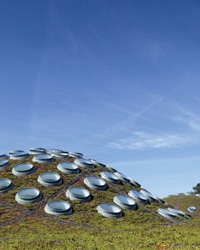 Tim Griffith/Courtesy of California<br />Academy of Sciences New American Green Landmarks
A skyscraper, city park, baseball stadium, hotel, museum, parking garage, restaurant, and more—all of them iconic, all of them green. This is what sustainable design looks like now.
Tim Griffith/Courtesy of California<br />Academy of Sciences New American Green Landmarks
A skyscraper, city park, baseball stadium, hotel, museum, parking garage, restaurant, and more—all of them iconic, all of them green. This is what sustainable design looks like now.
See our slideshow of Must-See Green American Landmarks.
From atop the High Line, the old elevated freight track that is about to debut as New York’s most revolutionary public park, you get a clear, wide-angle view of the future. The sculpted concrete walkways lined with meadow grasses aren’t particularly high-tech or avant-garde, but there is something absolutely of-the-moment about the patchwork of old and new, man-made and organic. Here’s a hulking, disused piece of our industrial heritage, rescued from demolition and reinvented as a work of contemporary design—design in which nature is seamlessly integrated into the architecture. It all makes for a surprising yet coherent whole: the High Line offers as good an indication as any of the shape and texture of the 21st century: recycled, green, and chic.
So where else can you go to see iconic green design?Some of the biggest shifts are still hard to find. For instance, you might not have noticed that the world’s largest wind farm, generating up to 735 megawatts a day, is in a place called Wingate, Texas. Or that there are plans to build a record-breaking 280-megawatt solar-power facility outside of Gila Bend, Arizona. Not exactly travel destinations, obviously—although some wind farms, like Wild Horse, in Ellensberg, Washington, do have visitors’ centers. For this story, we’ve identified places around the country—from Pocantico Hills, New York, and Mission, Texas, to Marin County, California—that are emblematic of a new generation of savvy, environmentally tuned design destinations that, in small ways and large, are changing the traveler’s landscape. Some of these projects are probably what you’d expect. Indeed, many have earned the U.S. Green Building Council’s Leadership in Energy and Environmental Design (LEED) certification, and a couple of them are institutions directly related to science and nature. But broad swaths of the culture that until recently seemed largely indifferent to the notion of sustainable design are jumping on the green bandwagon. The new baseball stadium in Washington, D.C., for example, just earned LEED certification. (And HOK Sport, the primary architectural firm for the park and America’s premier stadium designer, now employs a full-time sustainability coordinator.) Strategies that were considered a little oddball only a few years ago—like photovoltaic panels, green roofs, and wind turbines—are finding their way into the language of everyday architecture, everyday life, and everyday travel.